
Wine Culture and Information since 2002 - Volume 22
 Wine Culture and Information since 2002 - Volume 22 |
|
Comparing Cabernet SauvignonOne of the most common international grapes, cultivated in every wine country of the world and present in countless wines, is the protagonist of this month's comparative tasting |
|
Among the many grapes which from Bordeaux have spread all over the world, Cabernet Sauvignon is one of the most known ones. Protagonist of complex and full bodied wines, Cabernet Sauvignon has easily conquered the vineyards in every country of the world, frequently replacing the traditional local grapes. In many cases, Cabernet Sauvignon has quickly become the most frequent ally for local grapes giving origin to new wines of pretty “international” style. This is the case of Italy, and however very common in other wine countries of the world as well, in which Cabernet Sauvignon is frequently added to the traditional autochthonous grapes, such as Sangiovese, Nero d'Avola and Montepulciano, as to mention some examples. Cabernet Sauvignon is usually added in order to increase body and organoleptic complexity, however it is evident its use is also determined by commercial reasons, just like Merlot, the other famous red grape from Bordeaux. Besides its prestige and its indisputable reputation, Cabernet Sauvignon attracts wine producers also because of its high content in coloring substances, capable of giving wines intense and dark colors, the high content in polyphenols, capable of ensuring a good structure, as well as its pleasing organoleptic qualities, a richness of fruits which can be well matched to the barrique. By following the enological tradition of Bordeaux, Cabernet Sauvignon is used in the world for the production of wines strongly based on the famous model of the French region and which also provides for the use of Merlot and Cabernet Franc - rarely Malbec and Petit Verdot as well - the way it is suggested by the “recipe” better known as Bordeaux blend to which it is added the barrique. Wood factor is in fact a quality which is virtually impossible to divide from Cabernet Sauvignon, not only because of matters of fashion, but also for making “smoother” the astringent tannins of this renowned red grape. Rarely, Cabernet Sauvignon is vinified in inert tanks, such as steel and cement.
|
|
When cultivated and vinified by using quality criteria, Cabernet Sauvignon makes wines with full body and concentration, robust and complex however agreeable and elegant. Characterized by strong aromas of wild berries - in particular black currant and black cherry - Cabernet Sauvignon is a grape which can be perfectly matched to the organoleptic qualities passed from wood during aging. The most common type of cask used for fermenting and aging Cabernet Sauvignon is the barrique - the same used in Bordeaux - rarely large casks. Inert containers, such as steel or cement, are generally excluded from the vinification process of this grape, saved in very rare cases and in specific enological choices also determined by the viticultural characteristic of the grape. The goal of our tasting will be represented by the study of the impact of the wood in the organoleptic qualities of Cabernet Sauvignon, a factor present in the three selected wines.
The three wines selected for our comparative tasting are produced with 100% Cabernet Sauvignon, fermented and aged in barrique and coming from three different areas of Italy. The first selected wine is Castel Schwanburg's Alto Adige Cabernet Sauvignon Castel Schwanburg, aged for 18 months in barrique. The second wine is Boccadigabbia's Akronte, a 100% Cabernet Sauvignon from Marches and aged for about 20 months in barrique. The last wines is Gualdo del Re's Val di Cornia Suvereto Cabernet Sauvignon Federico Primo, produced in Tuscany and aged for about 14 months in barrique. In order to properly enhance the organoleptic qualities of the three wines - both aromatic and gustatory ones - it will be used a service temperature of 18° C (65° F). The comparative tasting will be done by using three ISO glasses, choosing for all the three wines the latest vintages currently commercialized.
|
||||||||
|
Cabernet Sauvignon is a grape rich in coloring substances, therefore its wines will generally have pretty intense and rich colors, with pretty reduced transparency, which sometimes avoid the passage of light. The colors which can be observed in wines produced with Cabernet Sauvignon - also thanks to their excellent longevity - range from purple red, typical during youth, to garnet or brick red, typical in the apex of its aging. However, the color which will be more frequently observed in Cabernet Sauvignon is ruby red, with pretty dark intensities, a color which will also be present after many years of aging. Just like any other red berried grape, the intensity and the concentration of color strongly changes according to the quality of grapes and, last but not the least, to the wine making techniques used in vinification. In wines produced with grapes cultivated with high yields criteria, the color of Cabernet Sauvignon will however show its characteristic ruby red color, although the transparency will be pretty evident. The first wine of which we will examine appearance is Castel Schwanburg's Alto Adige Cabernet Sauvignon. After having poured the wine in the glass, it will be observed the hue and intensity of its color. It will be noticed an intense and brilliant ruby red color, with a pretty reduced transparency. After having tilted the glass over a white surface, it will be observed ruby red nuances. Let's now examine the second wine, Boccadigabbia's Akronte. The color of this Cabernet Sauvignon is intense ruby red and, just like in the previous case, it will be observed a pretty reduced transparency. By tilting the glass, it will be noticed nuances of garnet red. We will now examine the appearance of the last wine, Gualdo del Re's Val di Cornia Suvereto Cabernet Sauvignon Federico Primo. The analogy with the previous wine is pretty evident, the wine has in fact an intense ruby red color and nuances of garnet red, however transparency will be even more reduced than Akronte.
|
|
The aromatic qualities of Cabernet Sauvignon are very rich and pleasing, including the intense aromas of fruits - in particular wild berries - to which are also added tertiary aromas developed during the aging in barrique, the most common wine making technique for this grape. Cabernet Sauvignon, when cultivated in cool climate areas or harvested not perfectly ripe, tends to develop vegetal aromas, the most common being bell pepper and green bell pepper, a characteristic which is also found in Cabernet Franc and, sometimes, in Merlot. Thanks to its capability of long periods of aging, the aromatic development of Cabernet Sauvignon is very interesting. Time in fact gives this grape very complex aromas, such as tobacco, licorice, coffee and cigar box. In Cabernet Sauvignon wines aged in barrique, it can be frequently perceived balsamic aromas of menthol and eucalyptus. Among the most characteristic aromas of fruit found in this grape, are mentioned black currant - the most typical one - black cherry, plum and blueberry. We will begin the olfactory analysis from Castel Schwanburg's Alto Adige Cabernet Sauvignon. By holding the glass in vertical position and without swirling it, we will do the first smell in order to determine opening aromas. It will be perceived intense aromas of plum and black currant - typical qualities in Cabernet Sauvignon - as well as the unmistakable aroma of vanilla, the witness of the 18 months of aging in barrique. After having swirled the glass in order to favor the oxygenation of wine, we will proceed with a second smell which will allow the perception of black cherry, black berry and violet aromas to which will follow aromas of licorice, tobacco, cinnamon, chocolate, nutmeg and a pleasing balsamic sensation recalling eucalyptus. It will be the noticed a pleasing aroma of green bell pepper, a quality which is typical in many Cabernet Sauvignon wines. We will now examine the second wine of our comparative tasting: Boccadigabbia's Akronte. By holding the glass in vertical position and without swirling, we will evaluate opening aromas which will be characterized by black cherry, plum and black currant, typical fruit aromas in Cabernet Sauvignon. The second smell, done after having swirled the glass, will allow the perception of blueberry and violet aromas, as well as vanilla, licorice, tobacco, cocoa and cinnamon. It will also be noticed a pleasing and light aroma of black pepper, whereas balsamic qualities in this wine will be more similar to menthol instead to eucalyptus. It will be noticed a slight and pleasing aroma of lavender and the typical aroma of bell pepper. Let's now evaluate the third wine, Gualdo del Re's Val di Cornia Suvereto Cabernet Sauvignon Federico Primo. Opening aromas offer hints of black cherry, plum and black currant, just like in Boccadigabbia's Akronte. After having swirled the glass, the sequence will be completed with aromas of blueberry, violet, vanilla, tobacco, licorice, cocoa, clover, mace and black pepper, as well as the typical balsamic aroma of eucalyptus.
|
||||
|
Cabernet Sauvignon is a grape whose wines are generally characterized by a good body, most of the times with a robust structure. Thanks to its important content in polyphenols, also responsible for structure, Cabernet Sauvignon wines generally have a pretty high astringency. It should be noticed the intensity of astringency varies according to the quality of grapes, viticultural criteria and wine making techniques, in particular the use of barrique and the level of toasting of wood. Cabernet Sauvignon is a grape which easily integrates with the organoleptic qualities of wood, a factor which usually have a “smoothing” effect on the harsh tannins of this grape. Wines produced with Cabernet Sauvignon are generally characterized by pretty high alcohol volumes - sometimes reaching 14% - a quality which is particularly useful to improve the balance with the richness in tannins and the low acidity. The first wine we will evaluate is Castel Schwanburg's Alto Adige Cabernet Sauvignon. The first sip will be characterized by a pretty evident astringency caused by tannins, however it will not be excessively aggressive also thanks to alcohol and the pleasing smoothness given by aging. Cabernet Sauvignon is a grape with a pretty limited quantity of acid substances: it should in fact be noticed the acidity of this wine is pretty low. The structure will be pretty robust, a quality we would certainly expect from such a wine. The second wine we will evaluate is Boccadigabbia's Akronte. The attack of this wine will be characterized by strong tannins with a full and robust structure, however it should be noticed how the wine is balanced thanks to the contribution of alcohol and roundness. Let's now pass to Gualdo al Re's Val di Cornia Suvereto Cabernet Sauvignon Federico Primo. Also in this case the attack will be pretty astringent with an evident full body, however well balanced both by alcohol and by its pleasing roundness. It should be noticed how in all the three wines can be perceived an excellent correspondence to the nose, in particular the flavors of black currant, plum and black cherry.
|
|
The three wines of our comparative tasting fully express the organoleptic qualities of Cabernet Sauvignon, in particular the robust structure and the astringency of tannins, as well as the typical aromas and flavors of black currant, black cherry and plum. The finish of Castel Schwanburg's Alto Adige Cabernet Sauvignon is persistent and characterized by the typical flavors of plum, black cherry and black currant. Also the finish of Boccadigabbia's Akronte is persistent with evident flavors of black currant, black cherry, plum and blueberry. The finish of the third wine, Gualdo del Re's Val di Cornia Suvereto Cabernet Sauvignon Federico Primo, does not disappoint expectations and confirms an excellent taste-olfactory persistence with intense flavors of black currant, black cherry and plum. In particular, it should be noticed the influence of the aging in barrique on the organoleptic qualities of the three wines: besides giving the typical tertiary and balsamic aromas, the passage in wood smooths the typical harshness of Cabernet Sauvignon's tannins, therefore making the wine smoother and more balanced.
|
Wines of the Month |
|
|
|
Score legend Prices are to be considered as indicative. Prices may vary according to the country or the shop where wines are bought |
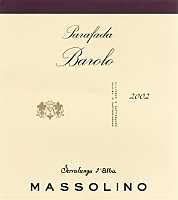
|
|
Barolo Parafada 2002 |
|
| Massolino (Piedmont, Italy) | |
| Grapes: Nebbiolo | |
| Price: € 31.00 | Score: |
| This Barolo shows a brilliant ruby red color and nuances of brick red, moderate transparency. The nose reveals intense, clean, pleasing, refined and elegant aromas which start with hints of cherry, violet and raspberry followed by aromas of plum, blueberry, vanilla, tobacco, cinnamon, licorice, pink pepper, rhubarb, cocoa, leather and menthol. The mouth has good correspondence to the nose, a tannic attack and pleasing crispness, however balanced by alcohol, full body, intense flavors, agreeable. The finish is persistent with flavors of cherry, raspberry and plum. A well made wine. Barolo Parafada ages for 24 months in barrique followed by at least 12 months of aging in bottle. | |
| Food Match: Game, Roasted meat, Stewed and braised meat, Hard cheese | |
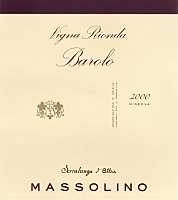
|
|
Barolo Riserva Vigna Rionda Riserva 2000 |
|
| Massolino (Piedmont, Italy) | |
| Grapes: Nebbiolo | |
| Price: € 46.00 | Score: |
| Barolo Riserva Vigna Rionda shows a brilliant ruby red color and nuances of brick red, moderate transparency. The nose reveals intense, clean, pleasing, refined and elegant aromas which start with hints of cherry and violet followed by aromas of blackberry, raspberry, plum, rose, vanilla, tobacco, licorice, cinnamon, cocoa, pink pepper and hints of menthol. The mouth has good correspondence to the nose, a tannic attack and pleasing crispness, however balanced by alcohol, full body, intense flavors, agreeable. The finish is persistent with flavors of cherry, plum and raspberry. A well made wine. This Barolo ages for 36 months in cask followed by 24 months of aging in bottle. | |
| Food Match: Game, Roasted meat, Stewed and braised meat, Hard cheese | |
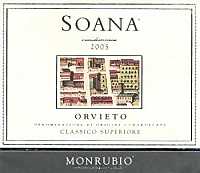
|
|
Orvieto Classico Superiore Soana 2005 |
|
| Cantina Monrubio (Umbria, Italy) | |
| Grapes: Trebbiano Toscano (30%), Grechetto (30%), Verdello (10%), Drupeggio (5%), Malvasia Bianca (5%), Sauvignon Blanc (20%) | |
| Price: € 7.50 | Score: |
| This Orvieto Classico Superiore shows a brilliant greenish yellow color and nuances of greenish yellow, very transparent. The nose reveals intense, clean and pleasing aromas that start with hints of pear, apple and broom followed by aromas of hawthorn, kiwi, plum and peach. The mouth has good correspondence to the nose, a crisp attack and however balanced by alcohol, good body, intense flavors. The finish is persistent with flavors of apple and pear. This wine ages in steel tanks. | |
| Food Match: Pasta and risotto with fish, Sauteed fish, Sauteed white meat | |

|
|
Palaia 2003 |
|
| Cantina Monrubio (Umbria, Italy) | |
| Grapes: Pinot Noir (34%), Merlot (33%), Cabernet Sauvignon (33%) | |
| Price: € 16.00 | Score: |
| Palaia shows a deep ruby red color and nuances of garnet red, little transparency. The nose reveals intense, clean, pleasing and refined aromas which start with hints of black cherry, plum and black currant followed by aromas of blueberry, violet, vanilla, tobacco, cocoa, leather and hints of eucalyptus. The mouth has good correspondence to the nose, a tannic attack and pleasing roundness, however balanced by alcohol, full body, intense flavors. The finish is persistent with flavors of black cherry, plum and black currant. Palaia ages for 12 months in barrique followed by 12 months of aging in bottle. | |
| Food Match: Roasted meat, Stewed and braised meat, Hard cheese | |
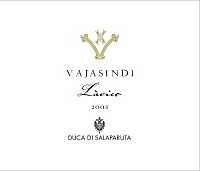
|
|
Vajasindi Làvico 2003 |
|
| Duca di Salaparuta (Sicily, Italia) | |
| Grapes: Nerello Mascalese (90%), Merlot (10%) | |
| Price: € 8.00 | Score: |
| The wine shows a brilliant ruby red color and nuances of brick red, moderate transparency. The nose denotes intense, clean, pleasing and refined aromas which start with hints of cherry, tamarind and vanilla followed by aromas of strawberry, raspberry, plum and cyclamen. The mouth has good correspondence to the nose, a slightly tannic attack and however balanced by alcohol, good body, intense flavors. The finish is persistent with flavors of cherry, raspberry and plum. Vajasindi Làvico ages for 12 months in barrique followed by at least 6 months of aging in bottle. | |
| Food Match: Stuffed pasta with mushrooms, Stewed meat with mushrooms | |
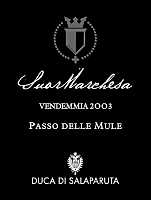
|
|
SuorMarchesa Passo delle Mule 2003 |
|
| Duca di Salaparuta (Sicily, Italia) | |
| Grapes: Nero d'Avola | |
| Price: € 8.50 | Score: |
| This wine shows a brilliant ruby red color and nuances of garnet red, little transparency. The nose denotes intense, clean, pleasing and refined aromas which start with hints of plum and black cherry followed by aromas of blackberry, carob, violet, vanilla, tobacco, mace and menthol. The mouth has good correspondence to the nose, a slightly tannic attack and pleasing roundness, however balanced by alcohol, good body, intense flavors. The finish is persistent with flavors of plum, black cherry and blackberry. Passo delle Mule ages for 10 months in barrique followed by 6-8 months of aging in bottle. | |
| Food Match: Broiled meat and barbecue, Stewed meat with mushrooms, Hard cheese | |
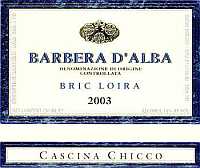
|
|
Barbera d'Alba Bric Loira 2003 |
|
| Cascina Chicco (Piedmont, Italy) | |
| Grapes: Barbera | |
| Price: € 15.00 | Score: |
| The wine shows an intense ruby red color and nuances of purple red, little transparency. The nose reveals intense, clean, pleasing, refined and elegant aromas which start with hints of black cherry, black berry and plum followed by aromas of blueberry, violet, vanilla, tobacco, licorice, cinnamon, cocoa, mace, pink pepper and mint. The mouth has good correspondence to the nose, a tannic attack and however balanced by alcohol, full body, intense flavors, agreeable. The finish is persistent with flavors of blackberry, black cherry and plum. A well made wine. This Barbera ages for 12 months in barrique. | |
| Food Match: Game, Roasted meat, Stewed and braised meat, Hard cheese | |
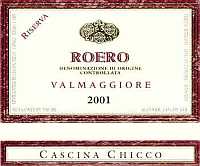
|
|
Roero Superiore Valmaggiore 2001 |
|
| Cascina Chicco (Piedmont, Italy) | |
| Grapes: Nebbiolo | |
| Price: € 15.00 | Score: |
| This Roero shows a brilliant ruby red color and nuances of garnet red, moderate transparency. The nose denotes intense, clean, pleasing, refined and elegant aromas that start with hints of cherry, raspberry and violet followed by aromas of plum, cyclamen, rose, vanilla, tobacco, cocoa, cinnamon, licorice, menthol and hints of leather. The mouth has good correspondence to the nose, a tannic attack and pleasing crispness, however balanced by alcohol, full body, intense flavors. The finish is persistent with flavors of cherry, plum and raspberry. A well made wine. Roero Valmaggiore ages for 24 months in barrique followed by 12 months of aging in bottle. | |
| Food Match: Game, Roasted meat, Braised and stewed meat, Hard cheese | |
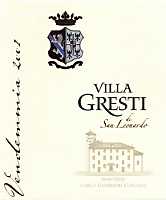
|
|
Villa Gresti 2001 |
|
| Tenuta San Leonardo (Trentino, Italy) | |
| Grapes: Merlot (90%), Carmenère (10%) | |
| Price: € 37.50 | Score: |
| Villa Gresti shows an intense ruby red color and nuances of garnet red, little transparency. The nose reveals intense, clean, pleasing, refined and elegant aromas which start with hints of black currant, black cherry and plum followed by aromas of blueberry, vanilla, violet, tobacco, chocolate, licorice, mace, chocolate and bell pepper. The mouth has good correspondence to the nose, a tannic attack and however balanced by alcohol, full body, intense flavors, agreeable. The finish is persistent with flavors of black currant, plum and black cherry. A well made wine. Villa Gresti ages for about 14 months in barrique followed by at least 12 months of aging in bottle. | |
| Food Match: Game, Roasted meat, Braised and stewed meat, Hard cheese | |
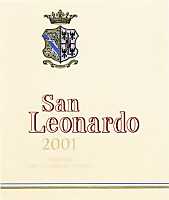
|
|
San Leonardo 2001 |
|
| Tenuta San Leonardo (Trentino, Italy) | |
| Grapes: Cabernet Sauvignon (60%), Cabernet Franc (30%), Merlot (10%) | |
| Price: € 43.00 | Score: |
| San Leonardo shows an intense ruby red color and nuances of garnet red color, little transparency. The nose reveals intense, clean, pleasing, refined and elegant aromas which start with hints of black currant, black cherry and plum followed by aromas of violet, vanilla, tobacco, licorice, chocolate, cigar box, clover, eucalyptus, mace and hints of black pepper. The mouth has very good correspondence to the nose, a tannic attack and however well balanced by alcohol, gull body, intense flavors, very agreeable. The finish is very persistent with long flavors of black currant, black cherry and plum. A great and well made wine. San Leonardo ages for 24 months in barrique followed by at least 12 months of aging in bottle. | |
| Food Match: Game, Roasted meat, Braised and stewed meat, Hard cheese | |
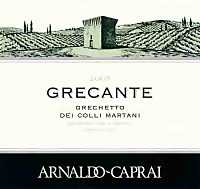
|
|
Grechetto dei Colli Martani Grecante 2005 |
|
| Arnaldo Caprai (Umbria, Italy) | |
| Grapes: Grechetto | |
| Price: € 7.00 | Score: |
| Grecante shows an intense greenish yellow color and nuances of greenish yellow, very transparent. The nose denotes intense, clean, pleasing and refined aromas that start with hints of pear, peach and hazelnut followed by aromas of apple, hawthorn, broom and pineapple. The mouth has good correspondence to the nose, a crisp attack and however balanced by alcohol, good body, intense flavors, agreeable. The finish is persistent with flavors of pear, peach and pineapple. Grecante ages for 3 months in steel tanks followed by 2 months of aging in bottle. | |
| Food Match: Pasta with fish and crustaceans, Sauteed fish, Sauteed white meat | |
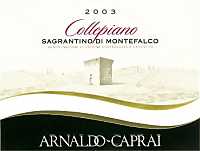
|
|
Sagrantino di Montefalco Collepiano 2003 |
|
| Arnaldo Caprai (Umbria, Italy) | |
| Grapes: Sagrantino | |
| Price: € 27.00 | Score: |
| This Sagrantino di Montefalco shows an intense ruby red color and nuances of garnet red, little transparency. The nose reveals intense, clean, pleasing and refined aromas which start with hints of plum, blackberry and black cherry followed by aromas of violet, blueberry, vanilla, chocolate, licorice, tobacco, mace and coffee. The mouth has good correspondence to the nose, a tannic attack and however balanced by alcohol, full body, intense flavors, agreeable. The finish is very persistent with flavors of blackberry, black cherry and plum. A well made wine. Sagrantino Collepiano ages in barrique for 22 months. | |
| Food Match: Game, Roasted meat, Stewed and braised meat, Hard cheese | |
|
||||||||
|
DiWineTaste Polls
|
| |||||||
Privacy Policy | |||||||


| Copyright © 2002-2024 Antonello Biancalana, DiWineTaste - All rights reserved |
| All rights reserved under international copyright conventions. No part of this publication and of this WEB site may be
reproduced or utilized in any form or by any means, electronic or mechanical, without permission in writing from DiWineTaste. |